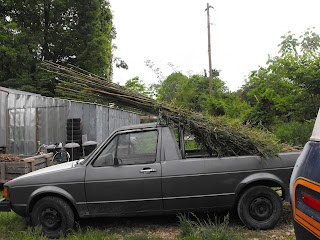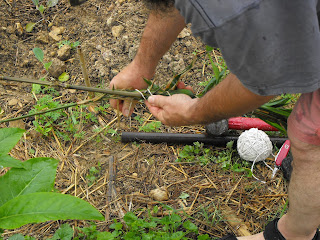A cane break that is.
Cane breaks received mention throughout Tennessee and Kentucky’s history. As far back as four to five thousand years
ago, Late Archaic and Early Woodland Indians were binding clusters of cane
together to light their way through caves in the karst region (I heard that from a Mammoth Cave guide I know). They also used it to weave baskets, and when
burying children, they would wrap the body “in a matting woven from the outer
bark of the cane”.[1] They would choose to live in the river
bottoms where cane grew in abundance “thirty feet tall and three inches thick”.[2]
For explorers and settlers it was, simply put, everlastingly
present as either a help or a hindrance.
Soldiers could hide in it during battle, and cattle would feed on the
young shoots, but where traveling through was concerned . . .
“Green, too, was the cane that covered most of the creek and river bottoms they rode through, miserable stuff, crowding in a close wall twenty feet high and more, shutting out light and air, but forever bending enough to whip a rider in the face.”[3]
And a man named Hamilton, a prisoner of war in 1775 reported
that they marched through “turrable cane breaks . . . [where the] musketoes
were not idle.”[4]
But I say, give me a cane break any day. I’d love to get one growing on our place and
we’ll be planting some in our miniature “wetland” soon. But for now we need to go to local cane
breaks along the creek to gather this incredible renewable resource.
Though bamboo would certainly make a perfect stick for a game of Pooh sticks, we do not, of course, just want to throw it on the
water as it says in the old song. As gardeners we have a multitude
of uses for bamboo cane. We can use it
to mark rows or individual plants in the garden. A few sticks of bamboo can be tied together
to make a reasonable tomato stake. We
can use them as poles for runner beans or trellises for peas.
And we can also build a hoop house out of them that will allow cherry
tomatoes and cucumbers to grow up the outside, thereby providing moderate shade
for plants growing under the hoops! This
is why Joe and I rose up early this morning and headed down to the creek with
lopping pruners and gloves to harvest cane.
 |
| Our cane haul |
 |
| Stripping side leaves off for clean main poles. |
 |
| Joe holding on to the cane to avoid falling off the face of the earth. |
 |
| Wrapping the cane with twine to join pieces together. |
 |
| Salvaging some old knotted twine (recycling!) |
 |
| Tying the first hoop down to a fence post (for stability and to make the hoops the right height) |
 |
| Tying the hoops to pieces of log to maintain proper height. |
 |
| Micah adding in side poles while Joe attaches the ridge pole. |
 |
| Tying the center pole to all of the hoops. |
[1]
Arnow, Harriette Simpson. 1960. Seedtime
on the Cumberland. Lexington:University press of Kentucky p. 51
[2] Ibid.
p. 20
[3] Ibid.
p. 221
[4] ibid
No comments:
Post a Comment